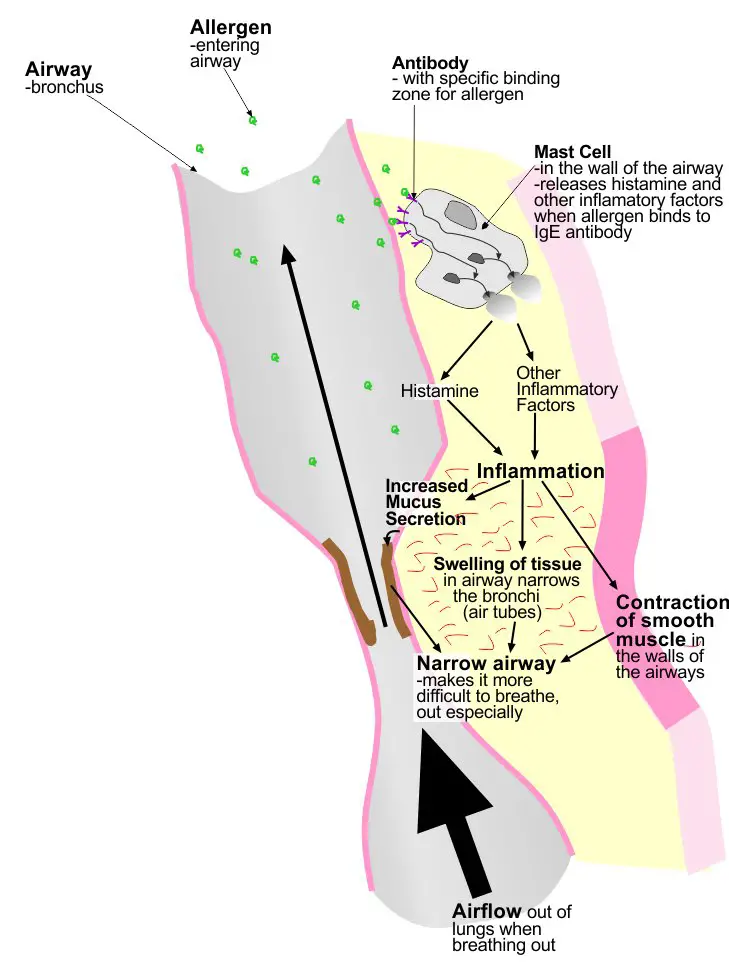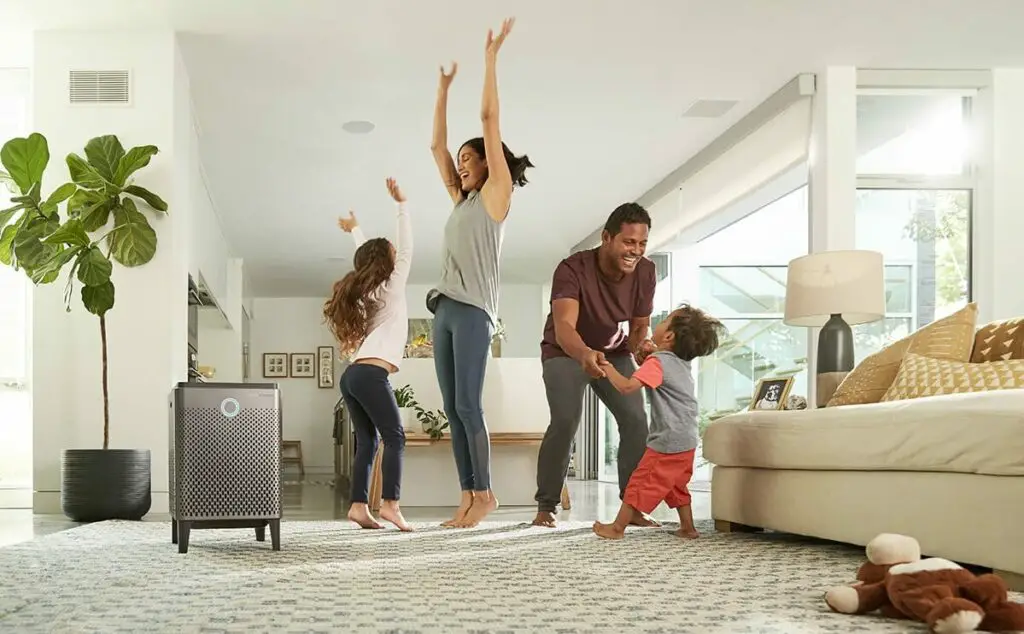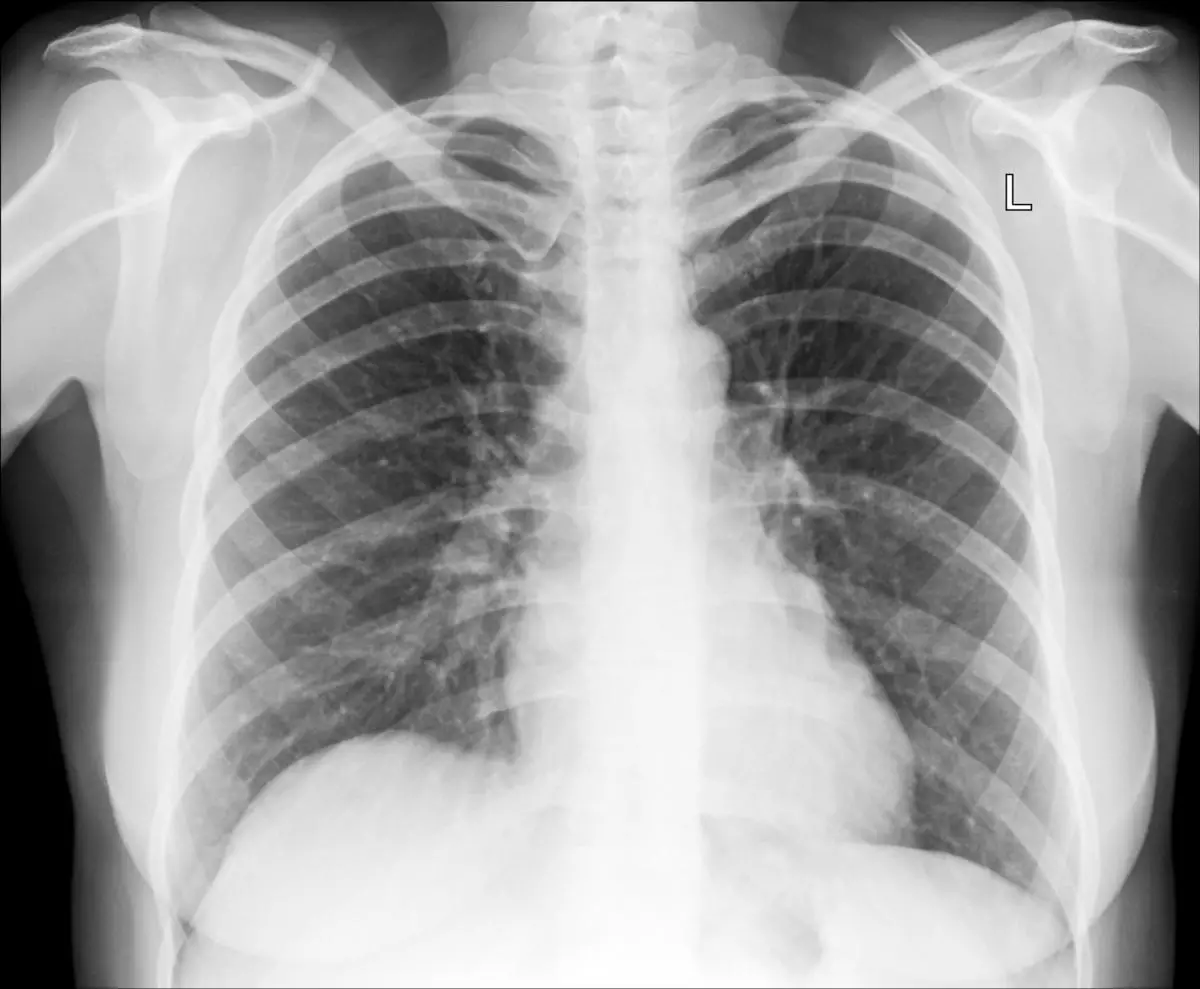There is recent evidence that air purifiers are effective for chronic obstructive pulmonary disease (COPD). So really everybody who has COPD should ideally have an air purifier. But which one? There are some air purifiers on the market that are expensive but would be useless for COPD. So let’s set about outlining the best choices.
The best air purifier for COPD is the IQ air HealthPro plus. It has supreme particle filtration and so will provide the cleanest possible air for breathing.
The reason for the choice of this air purifier will soon become apparent after a discussion of the illness itself and the characteristics of air purifiers. You will then have all the information you need to make an excellent choice.
COPD can be influenced by the quality of air breathed in. There are two main ways that this happens –
a)An allergic reaction causing inflammation
I outline this in the diagram below and in this article-“The best air purifier for allergies“

b)A non-allergic physical reaction causing inflammation.
In this case, airborne particles settle on the delicate lining of the airways in the lung-the bronchi. This usually non organic matter, such as particles from the exhaust of internal combustion engines and settles on the lining of the lung. Much of it is trapped in mucus which is gradually removed from the lungs by a mucociliary elevator. However, some reaches the underlying epithelium, the delicate lining of the bronchus, where it stimulates an inflammatory response.
As you can see, both of these pathways lead to inflammation. This causes the lining of the airway to swell, which leads to some obstruction of airflow.
What is the Evidence That Air Purifiers are Effective in COPD?
In one study they randomized 116 patients with COPD to six months’ use of in-home air cleaners. These had true HEPA filters as well as carbon filters or sham filters. They measured quality of life and exacerbations of their COPD. There were 68% fewer moderate exacerbations in the group with real air filters as opposed to the sham air filters in their air purifiers. Also, in individuals who use the air purifiers for at least 80% of the time, in line with the trial protocol, quality of life was also better.
So these studies suggest that exposure to airborne allergen and other particles in indoor air is important in determining respiratory symptoms in COPD, and that air purifiers are effective in reducing symptoms from COPD. They do not directly prove that the improvement in airways function was because of the reduction of allergen it could have been due to the reduction of other particles. They saw a 70% reduction in exacerbations of COPD by the air purifiers. This is similar to the best inhaler medication, so the effect of air purifiers was impressive.
This illustrates that air quality matters. However, it should be emphasised that properly purified air (minimum 80% particle reduction) should be breathed for at least 80% of the time and if possible more.
This is not to suggest that an air purifier should be used instead of inhaler medication, but simply that an air may be a useful addition to inhaler medication and is worth considering in anyone with obstructive airways disease.
As explained above, it is not just inert dust that causes a problem in people with COPD, exposure to allergens can also be a problem. In another recent study, 183 patients with chronic obstructive pulmonary disease (COPD) approximately 80% were exposed to at least one allergen. These allergens were from house dust mite, cockroach, cat, dog or mouse. Also, IgE (immunoglobulin E) blood tests showed that 17% were sensitized to at least one allergen.
Exposure to an allergen and sensitization to it was associated with 8% lower lung function, a decrease in respiratory scores and 2.3 fold risk for exacerbations. An “exacerbation” is where, for a period, breathing becomes significantly more difficult and this can need hospital admission. Pet dander and cockroach both caused these effects, but surprisingly house dust mite did not, although it was the most common allergen.
So allergen exposure through airborne allergen particles can make a considerable difference to quality of life in patients with COPD disease.
Is My Indoor Air Bad Enough to Need an Air Cleaner?
Atmospheric pollution is pervasive
According to EPA statistics in 2020 98% of areas in the United States for which there is data, have PM 2.5 particle pollution levels above the current WHO safe level. So the outdoor air fine particle pollution for most of the US population is above limits currently considered safe.
Ultrafine particles
A separate problem is that, even if your air quality is excellent from the point of view of fine particles as measured by most meters, there are approximately 1 million ultrafine particles per cubic liter (1.76 pints) of indoor air in the average office or home. Please see this video-
These are invisible to standard air quality meters. A standard laser diffraction meter will only accurately measure particles with a diameter of 0.5 micrometres and above accurately. Ultrafine particles are less than 0.1 micrometers in diameter, and sensors/meters to measure them cost of the order of $4000. So even if the atmosphere in your home is fine using a standard laser diffraction particle counter, there will still be millions of air particles that will be removed by a good air purifier.
Test your indoor air yourself
This seems a perfectly reasonable idea. However, as explained above any air quality meter you are likely to buy will not measure ultrafine particles. Also, even if it did measure ultrafine particles, there is no known safe limit for these as there is for PM 2.5, that is fine airborne particles. So if you have damaged airways in your lungs already, it seems wise to simply by an air purifier which will reduce the levels of all the airborne particles, including ultrafine particles.
The Best Air Purifier for COPD Should Have the Following Characteristics
1) Ability to remove the very smallest particles from the air
So as we have seen the great benefit of air purifiers is that they can remove ultrafine particles. However, only a few are specified to remove particles of 10 nm in diameter or smaller. These types of particles are usually inorganic, but some cat allergens get down into this range, as shown in this table –
| Allergen | Diameter (nm) |
|---|---|
| Pollen | 1300-30,000 |
| House Dust Mite | >10 (main allergen faecal balls size 10,000-40,000) |
| Rat Urinary Antigen | 7 |
| Cat allergen Fel d 1 | 2-10 |
So it is very important for an air purifier for COPD to be able to remove even the smallest particles, to minimize irritation of the airways.
2) An adequate air flow (CADR) to reduce particles by a high percentage
The airflow through an air purifier/air cleaner for a true HEPA filter should be almost exactly the same as the clean air delivery rate (CADR). This is because the filtration efficiency should be close to 100%-
CADR = filtration efficiency X airflow
However, you cannot assume this, very occasionally a quoted “airflow” from the manufacture will be without the filters in the machine! So you should look for the CADR when buying an air purifier. The EPA specifies CADR as the way of sizing the air purifier to the size of your room. However, some manufacturers do not specify it at all, and many do not specify CADR for all fan speeds.
The importance of airflow is that the level of particles, including allergen, decreases with increasing airflow. For instance, if you meet the minimum EPA (Environmental Protection Agency) standard 5 air changes per hour (ACH) then the particle/allergen count will drop by 80%. An air change is the whole volume of air in the room going through the air cleaner once.
However, in a real-world setting, even with a tremendous airflow through an air purifier/cleaner, it will not be possible to get the allergen count down to zero. This is mainly because the rooms are not perfectly sealed, fine particles can easily penetrate the envelope of a building. Even a window that seems closed will have gaps nanometers in width that will let fine and ultrafine particles in. Also, when we move around in the room, we agitate allergen that has dropped onto the floor back up into the air.
So why not have air purifiers that have a tremendously high airflow to lower particle count by 95%? This would work in theory, but would be far too noisy to live with. So the sound that you will be able to tolerate for long periods is likely to be a limiting factor. It may also decide which air purifier you feel is best for you. The Coway 400S and 300S have the highest airflow per decibel, so they will give you the highest airflow for whatever noise level is most comfortable for you on a long-term basis. There are more industrial air purifiers, such as the SmartAir Blast Industrial, which will give even higher air flows per decibel. However, the filter is currently not specified down to 10nm or below as the Coway and iQair are. Also, this air purifier is rather large for the domestic setting.
Features That Are Not Necessary
- Smart sensor-these are unnecessary and not an accurate enough a way of running an air purifier. Please see this article “Buying an Air Purifier“
- UV light-this does not help with airborne particles
Features That Are Not Essential and Should Not Sway a Buying Decision
Some features of an air purifier can be helpful, but are often associated with having a subpar filter or sometimes no filter at all. So they should not be used as a criterion for buying a particular air purifier. Here is a list of a few –
- Ionic mechanisms
- Plasma wave technology
- PECO technology
Again, this is all explained in more detail in this article – “Buying an Air Purifier“.
The Air Purifier Should Allow a Maximal Time For Breathing Purified Air
To maximize the time for which purified air is breathed, you will need a smart air purifier. That is , one that can switch itself on at least half an hour before you step into the room. This is because all air purifiers take time to lower the particle count in the room as much as they can achieve. Maximal lowering of particle count depends upon room and air purifier size, but it will normally take 30-60 minutes. So you could have an extra 1-2 hours per day of breathing purified air by buying smart air purifiers. This is because a smart air purifier can come on 60 minutes before you enter the room and prepare the air. You then step into a room with purified air.
Best Air Purifiers for COPD
1) iQair HealthPro Plus (supreme particle filtration)-only suitable for room size up to 262 sq ft*
This air purifier has the highest filter specification of any machine for the domestic market and is genuinely medical grade. It is only suitable for rooms up to 262 sq ft, assuming the room has 8ft ceilings unless you are very noise tolerant.
The pre-filter does not need cleaning. This is quite an advantage as most air purifiers have pre-filters which you should theoretically clean every 2-4 weeks!

| Filters | |
| HEPA filter | HEPA specified to remove 99.8% of ultrafine particles down to a size of 0.003um |
| Carbon filter amount of carbon (lb) | 5 lb so 40x more than some other appliances |
| Filter Change HEPA (Particles) | 15 months for pre filter 48 months for Hyper-HEPA filter |
| Filter Change Carbon (Chemicals) | 20 months |
| Airflow | |
| CADR at =<50db (CADR on Maximum) | 170 cfm |
| Maximum Room Size (Noise less than 50db*) | 262 sq ft |
| Maximum Room Size (On noisiest setting) | 462 sq ft |
| Smart Control | Yes smart plug |
| Power | 74 W |
| Weight | 35 lbs |
| Dimensions “H x “W x D” | 28x 15 x 16 |
| Annual Running Cost Electricity ($) | $45 |
| Annual Running Cost Filters ($) | $180 |
| Total Annual Running Cost ($) | $230 |
All the above are approximate and assume running the air purifier for 12 hours per day on the highest setting that keeps the noise below the level specified in db in the table. This is less than or equal to 50db in normal daytime use and 35db for bedrooms.
*Most people will not wish to have the air purifier on a setting louder than about 35db for sleeping in a bedroom-you may wish to have a quieter setting than 35db this is just a ballpark estimate for most people. On the other hand, if your room layout allows you to be much further than 6 feet from the air purifier you may find the noise this machine makes at top speed is alright. The calculations for room size assume that you have 8 foot ceilings and 5 air changes per hour.
Never run an air purifier on auto mode using the inbuilt sensor. These cannot detect ultrafine particles which are damaging to human health, please see this article- How to test the air quality in your home.
In view of its supreme particle filtration this is the obvious choice for best air purifier for COPD.
There is an extensive review of this air purifier here.
2) Coway 400S (suitable for large rooms and quiet)
This air purifier has a excellent filter, although with slightly lower specifications than the iQair. A high air flow Its special feature together with the lowest possible noise levels for the airflow.

| Filters | |
| HEPA filter | HEPA specified to remove 99.8% of ultrafine particles down to a size of 0.01um |
| Carbon filter amount of carbon (lb) | 1.5 lb so more than most other air purifiers |
| Filter Change HEPA (Particles) | 12 months |
| Filter Change Carbon (Chemicals) | 12 months |
| Airflow | |
| CADR at =<50db (CADR on Maximum) | |
| Maximum Room Size (Noise less than 50db*) | 450 sq ft |
| Maximum Room Size (On noisiest setting) | 640 sq ft |
| Smart Control | Yes phone app |
| Power | 66 W |
| Weight | 24.7 lbs |
| Dimensions “H x “W x D” | 22.8 x 14.8 x 14.8 |
| Annual Running Cost Electricity ($) | $40 |
| Annual Running Cost Filters ($) | $120 |
| Total Annual Running Cost ($) | $160 |
Conclusion
So the best air purifier for COPD is the iQair HealthPro plus for its supreme particle filtration. However, if you have a larger space in which to purify the air or are very noise sensitive, then you may find the Coway 400S better.

